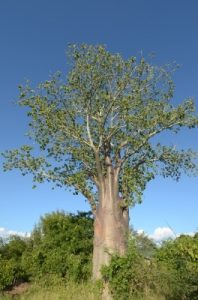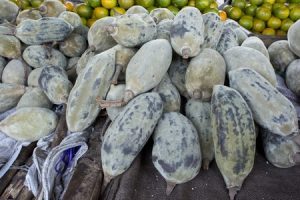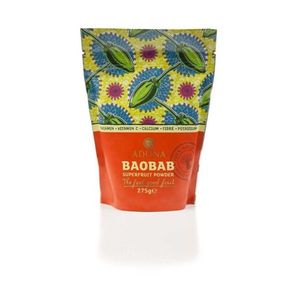
Baobab offers a nutritionally exceptional fruit pulp which packs a considerable punch in terms of minerals and vitamins, and perhaps most importantly, a fibre.
The baobab tree, apart from its curious appearance has been an important source of water and nutrition to the African tribes, especially the Hausa and Fulani ethnic groups of the semi-arid regions in the Sahel. The fruit pulp is used in both foods, cosmetics and medicines (De Caluwé et al., 2010). An extensive book covers all the pertinent features of the tree (Sidibe et al., 2002) and the vast range of products that have had such an important cultural impact (Chadare et al., 2002).

The Baobab tree (Adansonia digitata L. Family: Bombacaceae) is also known as the Monkey Bread Tree or Upside Down Tree because in appearance it simply looks to be planted the wrong way round. It is endemic to drought-prone regions of sub-Saharan Africa. It grows between 10 and 15 metres high but more noticeably has a trunk circumference of up to 20 metres which makes it appear squat but is ideally adapted to the semi-arid conditions in which it thrives. The tree grows in deep, well-drained soils at altitudes between 450m and 600m but where the rainfall may only be up to 500m. Its value to the tribes peoples of the area during arid spells, is in providing emergency water supplies which are found in hollow spaces of the trunk. Seven other species in the genus are only found in Madagascar.
Historically, the products of the tree were traded and was noted in the souk in Cairo back in the 1500s. In traditional medicine, the bark yielded a general febrifuge or anti-malarial, whilst the fruit was used to treat dysentery, the leaves as a remedy for colic, kidney and urinary disorders and as a poultice for skin wounds.
The seeds also yield a cold-pressed oil rich in palmitic, oleic and linoleic fatty acids which has lent itself extremely well to cosmetic applications and promoting healthy skin.
Baobab’s Nutritional Value
– The Benefits Of The Fruit Pulp
The Baobab produces huge pod like fruits, 15 cm in length containing about 100 bean-sized seeds. The powdery white fruit pulp or flour sits in a woody epicarp, surrounding the seeds, and is similar to cream of tartar.

The fruit pulp when soaked in water produces an acidic, high vitamin C drink. This pulp is commercially available from Eastern and Southern countries of Africa and has a high vitamin and mineral content. It is commonplace to leave the fruit pods on the branch to dry naturally before extracting the contents. The pulp contains about 220mg/100g of vitamin A, 300mg/100g of vitamin C, 2.13mg/100g of vitamin B6 and 7 mg/100g of iron as well as magnesium and potassium (Nour et al., 1980; Osman, 2004; Chadare et al., 2008).
The pulp has a fibre content of 48g/100g of which 15% is soluble and 25% is insoluble. The combination of soluble and insoluble fibres from a range of sources has the benefit of soothing and regulating the behaviour of the digestive tract, stabilizing intestinal-tract contractions, lowering LDL cholesterol levels, and raising levels of the helpful superoxide dismutase (SOD) enzyme, a free-radical inhibitor (Salovaara et al., 2007). Generally, fibre helps strengthen levels of immunity, lower inflammation which is linked to obesity related conditions and improve overall digestion.
The pulp’s acidity derives from the presence of both citric and tartaric acids. Any bioactives are derived from flavonols and triterpenoids and are stated to produce Strophantus type activity (Selvani and Hudson, 2009).
– Nutritional Properties Of The Leaves
The leaves are also rich in calcium – 1050mg to 3000mg/100g, magnesium, iron, potassium, zinc and amino-acids, and the mucilage is a main ingredient of a soup called ‘miyar kuka’ (Yazzie et al., 1994). This soup also includes guinea corn dough (fura) or pennisetum millet which is reduced to a gruel (kunu) that forms the traditional morning or midday meal (Nicol, 1957).
In regulatory terms, the baobab pulp, seed and leaf has been regularly imported into Italy for sale in both cosmetics and food. It is available throughout Europe now. A Commission E monograph is available.
Product Development Applications
From a product development viewpoint, the fruit pulp is commercially available and has a distinct taste, which could also provide vitamin C, iron and fibre. The fruit pulp powder can readily be used as a sprinkle on a range of products or in confectionary such as fruit bars. Suppliers also suggest the pulp could serve in ‘gluten-free’ products.
The leaves too would provide significant protein and mineral resources.
Much of the tree is used for other purposes too:- the bark for weaving and the seeds for roasting as snacks or for turning into a coffee-like substitute.
Commercial Baobab Products

Aduna™ offer a range of baobab fruit pulp powders where they have removed the seeds leaving the vitamin and mineral rich pulp which is dried and milled, to a powder for sprinkling on other foods or as an ingredient in baking and confectionary such as bars. Offerings include Baobab Super Fruit Powder in protective laminated cardboard cannisters in 80g and 170g sizes, and a space saving laminated pouch size of 275g. The powder is 100% vegan, vegetarian and organic.
References
Chadare, F.J., Linnemann, A.R., Hounhouigan, J.D., Nout, M.J.R., Van Boekel, M.A.J.S. (2008) Baobab food products: A review on their composition and nutritional value. Crit. Rev. Food Sci. Nutr. 49(3) pp. 254-274
De Caluwé, E., Halamová, K., Van Damme, P. (2010) Adansonia digitata L. – A review of traditional uses, phytochemistry and pharmacology. Afrika Focus 23(1) pp. 11-15
Nicol, B.M. (1957) Ascorbic acid content of Baobab fruit. Nature 180 pp. 287 doi:10.1038/180287a0
Nour, A.A., Magboul, B.I., Kheiri, N.H. (1980) Chemical composition of baobab fruit (Adansonia digitata L.). Trop. Sci. 22(4) pp. 384-388
Osman, M. (2004) Chemical and Nutrient Analysis of Baobab (Adansonia digitata) Fruit and Seed Protein Solubility. Plant Foods for Human Nutr. 59 pp. 29-33
Salovaara, H., Gates, F., Tenkanen, M. (2007) Dietary Fibre components and functions. Wageningen Academic Publ.,The Netherlands. ISBN: 978-90-8686-019-7
Selvani, V.; Hudson, J.B. (2009) Multiple inflammatory and antiviral activities in Adansonia digitata (Baobab) leaves, fruits and seeds. J. Med. Plants Res. 3(8) pp. 576-582
Sidibe, M., Williams, J.T., (2002) Baobab, Adansonia digitata L. Fruits for the Future 4. Edt. Hughes, A., Haq, I. Smith, R.W. Int. Centre for Underutilised Crops. Univ. Southampton.
Yazzie, D., Vander Jagt, J., Pastuszyn, A., Okolo, A., Glew, R.H. (1994) The Amino Acid and Mineral Content of Baobab (Adansonia digitata L.) Leaves. J. Food Comp. Anal. 7(3) pp. 189-193
Original article: 5th December 2013; 1st Revision: 25th October 2016
Leave a Reply